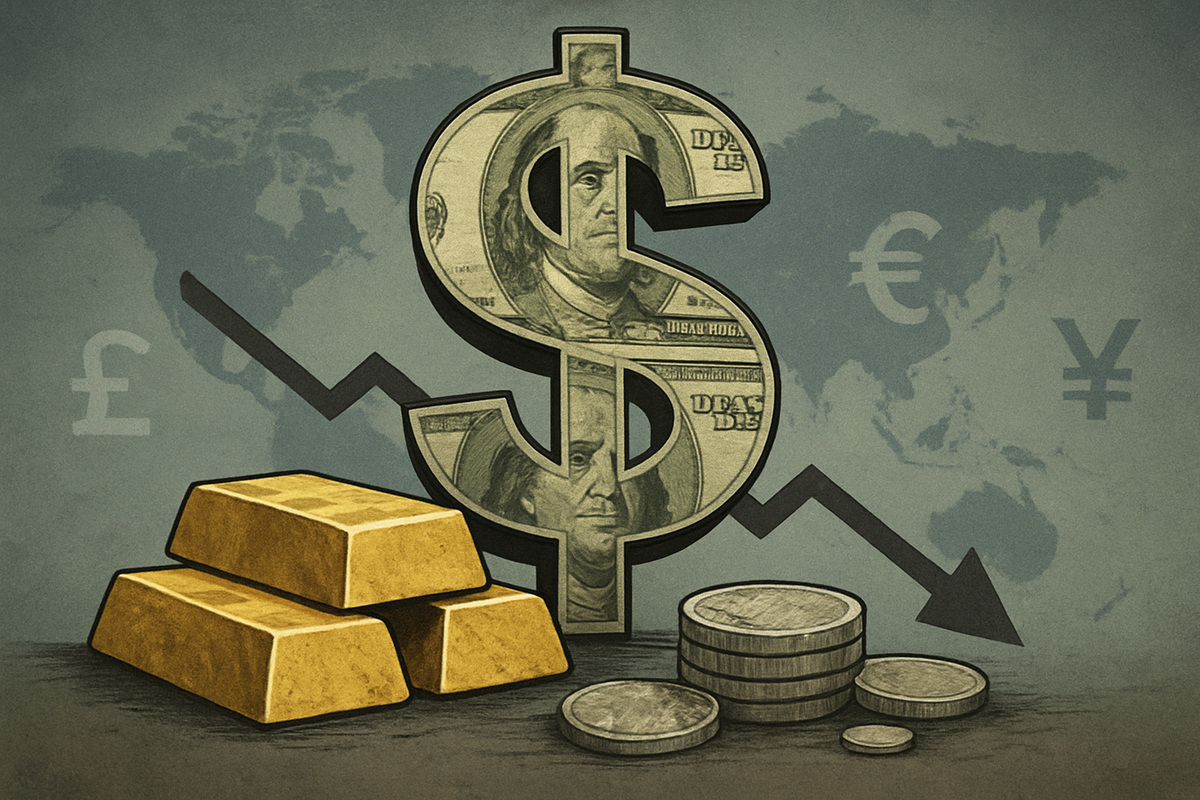
November 17, 2025 – The financial markets are currently witnessing a significant trend: a robust US Dollar exerting considerable downward pressure on the prices of gold and silver. This dynamic is creating a challenging environment for international buyers, as the increased strength of the greenback makes these precious metals more expensive when purchased with other currencies, thereby curbing global buying interest.
As of mid-November 2025, both gold and silver have seen declines in domestic futures markets, largely attributable to the dollar's appreciation. The dollar index recently gained 0.14%, a seemingly modest move that nonetheless amplifies the cost of dollar-denominated commodities for purchasers using euros, yen, or other foreign tender. This immediate implication is a reduction in demand from crucial international markets, directly impacting the global pricing of these traditional safe-haven assets.
The Dollar's Ascent: A Confluence of Factors
The recent firming of the US Dollar, which is now significantly influencing precious metal markets, is the result of a confluence of macroeconomic factors and policy signals. A primary driver has been the hawkish stance adopted by the US Federal Reserve. As of November 2025, comments from various Fed officials have largely tempered expectations for an immediate interest rate cut in December. This "higher-for-longer" interest rate outlook makes interest-bearing assets, such as US Treasury bonds, more attractive compared to non-yielding assets like gold and silver, drawing capital into dollar-denominated investments and bolstering the currency's value.
The timeline leading up to this moment has been characterized by careful observation of US economic data. Market participants are intensely focused on upcoming reports, particularly the nonfarm payrolls, which are anticipated to offer critical insights into the health and trajectory of the US economy. These data points are crucial in guiding the Federal Reserve's monetary policy decisions. Delays in the release of some government economic data have only heightened this anticipation, contributing to market uncertainty and, paradoxically, a flight to the perceived safety of the dollar. While geopolitical developments and broader economic uncertainties typically fuel safe-haven demand for gold and silver, the recent resolution of a US government shutdown eased some of that immediate safe-haven appeal, further contributing to the softening of precious metal prices. Key players in this scenario include the US Federal Reserve, which sets monetary policy; international central banks whose policies influence their respective currencies against the dollar; and global investors who reallocate portfolios based on interest rate differentials and currency strength.
Corporate Fortunes: Winners and Losers in the Precious Metals Sector
A strong US Dollar creates a distinct divide between potential winners and losers within the precious metals industry, particularly impacting mining companies and international dealers. For major gold and silver mining companies such as Barrick Gold (NYSE: GOLD) and Newmont (NYSE: NEM), a decline in the dollar-denominated price of their commodities can directly erode their revenue streams. While their extraction costs, often denominated in local currencies, might remain stable or even decrease relative to a stronger dollar, the lower selling price per ounce directly hits their top line. This can lead to reduced profitability, tighter margins, and potentially scaled-back exploration or development projects. Companies with significant international operations and cost bases in weaker currencies might experience some offsetting benefits, but the overarching pressure of lower commodity prices remains a significant headwind.
Conversely, some entities might find themselves in a relatively advantageous position. Precious metals refiners or manufacturers that source their raw materials internationally might benefit from a stronger dollar, as it effectively reduces the cost of their dollar-denominated purchases. However, this benefit is often mitigated by the decreased demand from their own international customer base who face higher costs. International buyers of gold and silver, whether individual investors, jewelers, or industrial users, are the clearest "winners" in this scenario, as their purchasing power for these metals diminishes. This can lead to a slowdown in physical demand from key markets like India and China, which are traditionally major consumers of gold. Companies involved in industrial applications of silver, such as solar panel manufacturers or electronics firms, might also face higher input costs if they source silver internationally and operate in a non-dollar economy, potentially impacting their overall production costs and competitive pricing.
Wider Implications and Historical Context
The current impact of a firm US Dollar on gold and silver prices extends beyond immediate market fluctuations, reflecting broader industry trends and historical precedents. This scenario underscores the fundamental inverse relationship between the dollar's strength and commodity prices, particularly those priced in USD. In a globalized economy, a strong dollar can have ripple effects across various sectors. For instance, it can make US exports more expensive, potentially impacting American manufacturers, while making imports cheaper, which could benefit US consumers but challenge domestic industries competing with imports. Emerging markets, often laden with dollar-denominated debt, face increased repayment burdens when their local currencies weaken against the dollar, potentially leading to capital outflows and economic instability.
Historically, periods of sustained dollar strength have consistently put pressure on precious metals. During times of economic stability and rising interest rates in the US, investors tend to favor dollar-denominated assets over non-yielding gold and silver. For example, during the early 1980s, when the Federal Reserve aggressively raised interest rates to combat inflation, the dollar surged, and gold prices experienced a significant decline from their earlier peaks. Similarly, in the mid-1990s, a robust US economy and strong dollar contributed to a prolonged bear market for gold. Regulatory and policy implications often revolve around central bank responses. If a strong dollar leads to significant economic stress in other nations, their central banks might intervene to stabilize their currencies, potentially influencing global liquidity and further impacting commodity markets. The current environment also highlights the ongoing debate about the role of gold as an inflation hedge versus a safe-haven asset; while inflation concerns might theoretically support gold, a dominant strong dollar narrative can overshadow this.
Navigating the Future: What Comes Next?
Looking ahead, the trajectory of the US Dollar will continue to be the paramount factor influencing gold and silver prices. In the short term, market participants will be keenly watching upcoming US economic data, especially the nonfarm payrolls report and subsequent inflation figures, for clues regarding the Federal Reserve's next moves. If economic data remains strong, reinforcing the "higher-for-longer" interest rate narrative, the dollar could maintain or even extend its current strength, continuing to weigh on precious metals. Conversely, any signs of economic softening or an unexpected dovish pivot from the Fed could lead to a dollar weakening, offering a potential reprieve and upward momentum for gold and silver.
In the long term, the global economic landscape and geopolitical stability will also play significant roles. Persistent geopolitical tensions or renewed concerns about global economic growth could re-ignite safe-haven demand for gold, potentially decoupling its performance from the dollar to some extent. Investors and companies in the precious metals sector may need to adapt strategically. This could involve hedging currency exposure for international transactions, diversifying investment portfolios, or for mining companies, focusing on cost efficiencies to maintain profitability in a lower price environment. Market opportunities may emerge for those who anticipate a dollar reversal, allowing them to "buy on dips" in anticipation of future appreciation. However, the immediate challenge remains the strong dollar, and potential scenarios range from continued precious metal price suppression to a gradual recovery should the dollar's ascent temper.
A Crucial Juncture for Precious Metals
In summary, the current strength of the US Dollar represents a critical juncture for gold and silver markets. While both metals are on track for one of their strongest annual performances in decades, the immediate pressure from a firm dollar and hawkish Federal Reserve commentary is undeniable. This dynamic disproportionately impacts international buyers, making dollar-denominated precious metals more expensive and thus dampening global demand. The fortunes of major mining companies like Barrick Gold (NYSE: GOLD) and Newmont (NYSE: NEM) are intrinsically linked to these price movements, necessitating strategic adaptations to maintain profitability.
Moving forward, investors should closely monitor the Federal Reserve's monetary policy signals, particularly concerning interest rate adjustments, and key US economic indicators. The interplay between the dollar's strength, inflation expectations, and geopolitical developments will define the market's trajectory. While the short-term outlook suggests continued headwinds for gold and silver due to the dollar's dominance, the long-term potential for these assets as hedges against uncertainty remains a key consideration. The coming months will reveal whether the dollar's reign continues unchallenged or if a shift in economic fundamentals allows precious metals to reclaim their luster.
This content is intended for informational purposes only and is not financial advice






